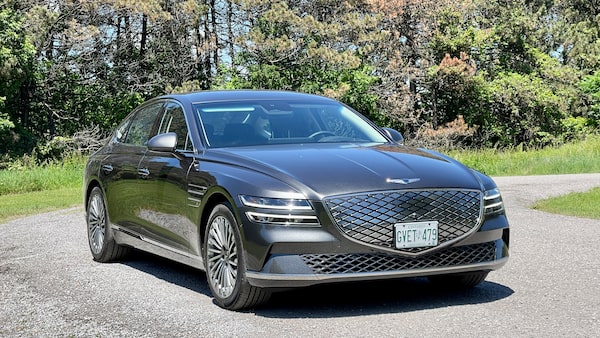
The new Genesis Electrified G80.Mark Richardson/The Globe and Mail
It takes a sharp eye to realize the new Genesis Electrified G80 is an electric car. There’s no external badging to say so, and the charge port is hidden behind the front grille – I had to go into the owner’s manual to find where it is. The only way to know the EG80 is an EV is by squinting at that diamond-shaped front grille and realizing it’s a solid piece of plastic, not mesh.
This is a premium mid-sized sedan, and Genesis has not yet released its price despite it being available this fall. (I guess it will be between $90,000 and $100,000.) The regular gas-powered G80 tops out at $80,000 plus tax and this car is nearly identical, except that it’s powered entirely by an 800-volt electrical system and an 87.2 kilowatt-hour battery.
That’s a larger battery than the just-released GV60 EV, but this is a larger vehicle. The GV60 is a luxurious crossover with space in the back for your kids or friends or a short-legged dog when the seats are down. The EG80 has space in the back for business clients, and the trunk has lost some room to ensure they can stretch their legs.
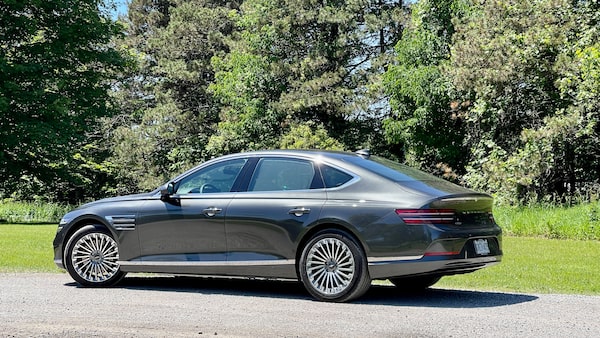

The charging port for the EG80 is hidden behind the front grille. The car looks very similar to its gas-powered sibling except the diamond-shaped grille is a solid piece of plastic, not mesh.Mark Richardson/The Globe and Mail
The larger battery provides an official range of 454 kilometres, and that was quite realistic in my week of summer driving. This range is when the drive mode is set to Eco, which cuts back the available power and the strength of the climate control. Switching to Comfort mode dropped the range by 20 kilometres and on a hot day, if the car was not already preconditioned to be cool inside while still plugged in, the full-blast air conditioning could drop the range an additional 20 kilometres. Switching to Sport mode drops an extra 20 kilometres.
So, a realistic and comfortable range of at least 400 kilometres in June weather, which probably means at least 300 kilometres in January. A heat pump and battery heater are standard equipment, which help.
The larger battery also consumes more power. I plugged the EG80 into an older Level 2 home charger that provided a paltry 6.4 kilowatts of power and it showed it would take about 10 hours to recharge from 32 per cent. In other words, if you’re buying a home charger, make sure you get the most powerful unit you can afford.
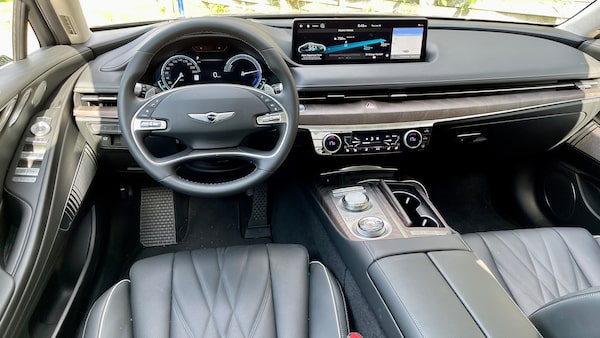
The front seats and dash of the EG80.Mark Richardson/The Globe and Mail
For all that, however, my fuel costs were negligible during my time with the car, which would not have been the case in the regular G80. The two sedans are so similar inside that the real question is, why choose one over the other?
It’s not because of cost, because at this price, owners likely aren’t looking to save a few bucks on fuel. If the EG80 does retail for $20,000 more than the gas car, then at today’s prices of around $2 a litre, it will take 10,000 litres of fuel to make up the difference, which is about 90,000 kilometres of driving for the 3.5-litre V6, or 100,000 kilometres for the 2.5-litre inline-four.
(That’s just accounting for the fuel at today’s prices, and doesn’t include the savings in maintenance and wear-and-tear. Genesis includes all basic required maintenance for five years in the purchase price.)
The electric vehicle is about the same weight as its gas-powered sibling, because it uses more lightweight metal instead of traditional steel, and its body is also 17 per cent more rigid. But the regular G80 is already agile for its size, and few drivers will be swayed by an even sportier drive.
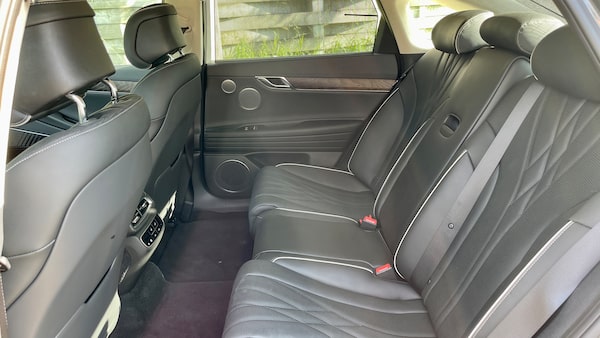

The trunk of the EG80 has lost some room compared to the gas-powered G80 to ensure rear seat passengers can stretch their legs. Still, the trunk is big enough for a large suitcase, or two golf bags.Mark Richardson/The Globe and Mail
The advantage comes in the smoothness of the drive itself, which is both exceptional and powerful. It also provides the status of being able to say your vehicle is purely electric, just like one of those Tesla Model S sedans that currently hold all the bragging rights. The EG80, however, will undoubtedly be much less expensive and probably be better finished.
It’ll be tough to persuade drivers to buy a costly Genesis when the alternatives are an even more costly Tesla or the soon-to-arrive Mercedes EQS. It isn’t impossible though, especially if the purchase price is $90,000 or less, and the Korean maker is pushing hard for the EV crown.
Tech specs
Genesis Electrified G80
- Price: ($90,000-$100,000 estimated)
- Motor: Two 136-kilowatt motors, one on each axle; 365 horsepower, 516 lbs.-ft.
- Drive: All-wheel drive
- Battery: 87.2 kilowatt-hour
- Claimed range: 454 kilometres
- Alternatives: Tesla Model S, Mercedes-Benz EQS
Looks
It’s an attractive sedan with 19-inch wheels that come standard. The signature parallel lights tell others on the road it’s a Genesis.
Interior
The seats are comfortable, but I found the quilted seats of the GV60 to be more comfortable. The cabin also uses “eco-friendly” materials, but there is no vegan-friendly alternative. I found the smaller, $79,000 crossover GV60 to be better equipped, with massaging seats, a fun boost button on the steering wheel and a lovely crystal sphere that flips over to become the transmission dial. None of these are available on the EG80.
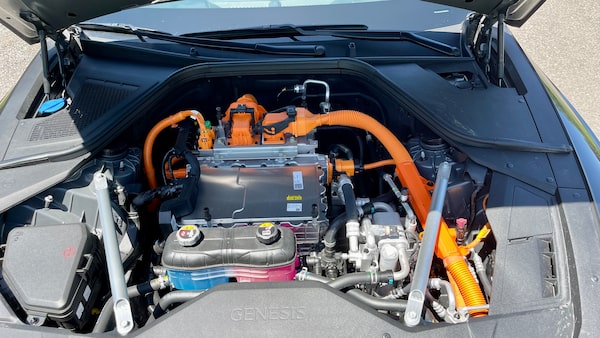
Under the hood of the EG80.Mark Richardson/The Globe and Mail
Performance
The EG80 is very quick if you want it to be, and like all EVs, it develops maximum torque right from standstill. The car is quickest in Sport mode, but it will squeal the tires when you step on the pedal if you want to try to impress passengers. It makes about the same horsepower as the 3.5-litre G80, but torque is considerably more, at 516 pounds-feet compared to the gas car’s 391.
Technology
Like the GV60, the Hyundai Ioniq 5 and the Kia EV6, the Electrified G80 uses an 800-volt electrical system that allows ultra-fast charging at up to 350 kilowatts. This is future-proofing though, because there aren’t many public chargers in Canada capable of such power, and even if you find one, it will be a lot slower if the outside temperature is colder than the optimal 23 degrees Celsius.
The safety of the drive itself benefits from all the driver’s assistance features that Genesis can think of. I drove in heavy traffic on Highway 401 across the top of Toronto for extended periods of up to five minutes at a time without touching the pedals or steering wheel. Like all manufacturers, the car is capable of such semi-autonomous driving – the level of intrusion is just a question of the maker’s appetite for potential lawsuits in the case of a collision.
Cargo
The trunk of the EG80 is about three-quarters the size of the trunk in the regular G80, at 304 litres. That’s still big enough for a large suitcase, or two golf bags.
The verdict
It all comes down to price. If the Genesis EG80 comes in at less than $100,000, it will give the more expensive (and desirable) brands of Tesla and Mercedes-Benz a run for their money. The Electrified G80 doesn’t have the truly premium touches of the GV60, nor the EQS, but it has the technological sophistication and the understated luxury that many drivers of mid-sized sedans are looking for.
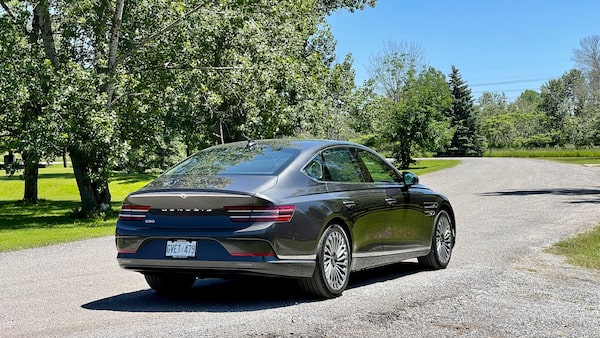
Mark Richardson/The Globe and Mail
Shopping for a new car? Check out the new Globe Drive Build and Price Tool to see the latest discounts, rebates and rates on new cars, trucks and SUVs. Click here to get your price.
 Mark Richardson
Mark Richardson